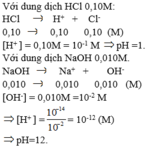Hãy nhập câu hỏi của bạn vào đây, nếu là tài khoản VIP, bạn sẽ được ưu tiên trả lời.

a, \(n_{HCl}=0,2.0,1=0,02\left(mol\right)=n_{H^+}=n_{Cl^-}\)
\(n_{H_2SO_4}=0,2.0,15=0,03\left(mol\right)=n_{SO_4^{2-}}\) \(\Rightarrow n_{H^+}=2n_{H_2SO_4}=0,06\left(mol\right)\)
\(\Rightarrow\Sigma n_{H^+}=0,02+0,06=0,08\left(mol\right)\)
\(n_{Ba\left(OH\right)_2}=0,3.0,05=0,015\left(mol\right)=n_{Ba^{2+}}\)
\(\Rightarrow n_{OH^-}=2n_{Ba\left(OH\right)_2}=0,03\left(mol\right)\)
\(H^++OH^-\rightarrow H_2O\)
0,03___0,03 (mol) ⇒ nH+ dư = 0,05 (mol)
\(Ba^{2+}+SO_4^{2-}\rightarrow BaSO_4\)
0,015___0,015______0,015 (mol) ⇒ nSO42- dư = 0,015 (mol)
⇒ m = mBaSO4 = 0,015.233 = 3,495 (g)
\(\left[Cl^-\right]=\dfrac{0,02}{0,2+0,3}=0,04\left(M\right)\)
\(\left[H^+\right]=\dfrac{0,05}{0,2+0,3}=0,1\left(M\right)\)
\(\left[SO_4^{2-}\right]=\dfrac{0,015}{0,2+0,3}=0,03\left(M\right)\)
b, pH = -log[H+] = 1

\(n_{Ba\left(OH\right)_2}=0,3.0,1=0,03\left(mol\right)\\ n_{HCl}=0,2.0,15=0,03\left(mol\right)\\ Ba\left(OH\right)_2+2HCl\rightarrow BaCl_2+2H_2O\\ Vì:\dfrac{n_{Ba\left(OH\right)_2\left(đề\right)}}{n_{Ba\left(OH\right)_2\left(PTHH\right)}}=\dfrac{0,03}{1}>\dfrac{n_{HCl\left(đề\right)}}{n_{HCl\left(PTHH\right)}}=\dfrac{0,03}{2}\\ \Rightarrow Ba\left(OH\right)_2dư\\ n_{Ba\left(OH\right)_2\left(p.ứ\right)}=\dfrac{n_{HCl}}{2}=\dfrac{0,03}{2}=0,015\\ n_{Ba\left(OH\right)_2\left(dư\right)}=0,03-0,015=0,015\left(mol\right)\\ \left[OH^-\right]=2.\left[Ba\left(OH\right)_2\left(dư\right)\right]=\dfrac{0,015}{0,3+0,2}=0,03\left(M\right)\\ \Rightarrow pH=14+log\left[OH^-\right]=14+log\left[0,03\right]\approx12,477\)
Nồng độ mol/lít các ion trong dd A:
\(\left[OH^-\left(dư\right)\right]=0,06\left(M\right)\left(nt\right)\\\left[Cl^-\right]=2.\left[BaCl_2\right]=2.\left(\dfrac{0,015}{0,5}\right)=0,06\left(M\right)\\ \left[Ba^{2+}\right]=0,03+ 0,03=0,06\left(M\right)\)

a) Ta có: \(n_{Al\left(NO_3\right)_3}=\dfrac{4,26}{213}=0,02\left(mol\right)\) \(\Rightarrow\left\{{}\begin{matrix}n_{Al^+}=0,02\left(mol\right)\\n_{NO_3^-}=0,06\left(mol\right)\end{matrix}\right.\)
\(\Rightarrow\left\{{}\begin{matrix}\left[Al^+\right]=\dfrac{0,02}{0,1}=0,2\left(M\right)\\\left[NO_3^-\right]=\dfrac{0,06}{0,1}=0,6\left(M\right)\end{matrix}\right.\)
b) Ta có: \(\left[Na^+\right]=0,1+0,02\cdot2+0,3=0,304\left(M\right)\)
c) Bạn xem lại đề !!

2. Tính nồng độ mol/l của các dung dịch:
a) Dung dịch H2SO4 có pH = 4.
\(pH=4\Rightarrow\left[H^+\right]=10^{-4}M\)
=> \(CM_{H_2SO_4}=\dfrac{\left[H^+\right]}{2}=\dfrac{10^{-4}}{2}=5.10^{-5M}\)
b) Dung dịch KOH có pH = 11.
\(pH=11\Rightarrow pOH=14-11=3\)
=> \(\left[OH^-\right]=10^{-3}=CM_{KOH}\)
3. Pha loãng 200ml dung dịch Ba(OH)2 với 1,3 lít nước thu được dung dịch có pH = 12. Tính nồng độ mol/l của dung dịch Ba(OH)2 ban đầu, biết rằng Ba(OH)2 phân ly hoàn toàn.
Đặt CM Ba(OH)2 = xM
=> \(n_{Ba\left(OH\right)_2}=0,2x\left(mol\right)\)
\(V_{sau}=V_{Ba\left(OH\right)_2}+V_{H_2O}=0,2+1,3=1,5\left(l\right)\)
pH=12 => pOH=2 => \(\left[OH^-\right]=10^{-2}M\)
\(Ba\left(OH\right)_2\rightarrow Ba^{2+}+2OH^-\)
0,2x----------------------------->0,4x
=> \(\left[OH^-\right]=\dfrac{0,4x}{1,5}=10^{-2}\)
=> x=0,0375M
Vậy nồng độ mol/l của dung dịch Ba(OH)2 ban đầu là 0,0375M

Gọi số mol Na2CO3, KHCO3 trong A lần lượt là x, y
Trong A:
nCO3 2- = nNa2CO3 = x mol
nHCO3- = nKHCO3 = y mol
nHCl = 0,15 . 1 = 0,15 mol
nH+ = nHCl = 0,15 mol
Cho từ từ HCl vào A:
nCO2 = 1,008 : 22,4 = 0,045 mol
H+ + CO3 2- → HCO3-
______x _______ x
HCO3- + H+ → CO2↑ + H2O
0,045___0,045___0,045
B tác dụng với Ba(OH)2 dư tạo kết tủa nên H+ phản ứng hết, trong B còn HCO3- dư
nH+ = x + 0,045 = 0,15
→ x = 0,105
nHCO3- trong B = x + y - 0,045 = 0,105 + y - 0,045 = 0,06 + y (mol)
B tác dụng với Ba(OH)2 dư:
HCO3- + OH- → CO3 2- + H2O
CO32- + Ba2+ → BaCO3↓
nBaCO3 = 29,55 : 197 = 0,15 mol
nHCO3- = nBaCO3 = 0,15 mol
→ 0,06 + y = 0,15
→ y = 0,09
\(CM_{Na2CO3}=\frac{0,105}{0,5}=0,21M\)
\(CM_{KHCO3}=\frac{0,09}{0,5}=0,18M\)

a, \(\left\{{}\begin{matrix}n_{Ba^{2+}}=4.10^{-3}\left(mol\right)\\n_{Na^+}=3.10^{-3}\left(mol\right)\\n_{OH^-}=0,011\left(mol\right)\end{matrix}\right.\)
\(\Rightarrow\left\{{}\begin{matrix}\left[Ba^{2+}\right]=\dfrac{4.10^{-3}}{0,2+0,3}=0,008M\\\left[Na^+\right]=\dfrac{3.10^{-3}}{0,2+0,3}=0,006M\\\left[OH^-\right]=\dfrac{0,011}{0,2+0,3}=0,022M\end{matrix}\right.\)
b, Để trung hòa dung dịch A thì:
\(n_{H^+}=n_{OH^-}\)
\(\Leftrightarrow0,01.V_{ddHCl}=\left(0,02.2+0,01\right).0,2\)
\(\Leftrightarrow V_{ddHCl}=1\left(l\right)\)

Đáp án A
nOH- = 2,75.10-1 = 0,275 mol; nH+ = 2,25.10-1 = 0,225 mol
H+ + OH- → H2O
0,225 0,275
nOH- dư = 0,05 mol; nCl- = nHCl = 0,225 mol; nBa2+ = 0,1375 mol
Dung dịch sau phản ứng có chứa BaCl2: 0,1125 mol; Ba(OH)2 dư 0,025 mol
Nồng độ mol của BaCl2 là 0,1125/5 = 0,0225M
Nồng độ mol của Ba(OH) 2 dư là 0,025/5 = 5.10-3M

thank ạ